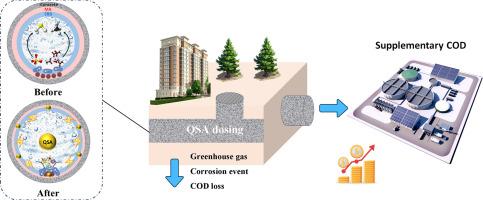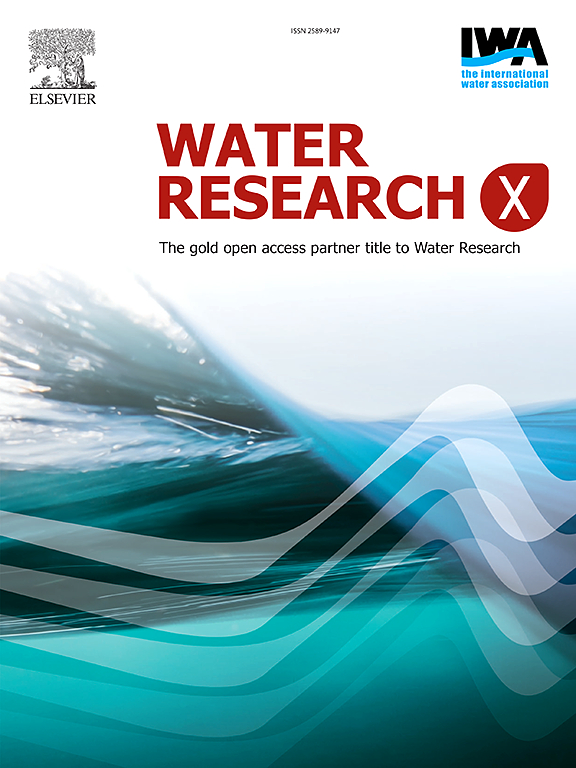应用有机硅季铵盐(QSA)减少下水道的碳足迹:对硫化物生成和甲烷生成的长期抑制作用
IF 8.2
2区 环境科学与生态学
Q1 ENGINEERING, ENVIRONMENTAL
引用次数: 0
摘要
在下水道管理中,产生硫化物和甲烷的过程是不可取的,但由此产生的有机物损失问题却往往被忽视。旨在控制硫化物和甲烷的传统化学加药方法通常涉及类似的氧化和/或沉淀机制。此外,以往的重点都集中在提高控制效果上,而不是研究投加的化学品与生物膜之间的相互作用。在这项研究中,75 mg-N/L 的有机硅季铵盐(QSA)首先被用于实验室加压下水道反应器中。经过三次加药,硫化物生成活性在 20 天后恢复到 50%,且没有进一步升高。与此同时,甲烷生成活性稳定在约 11%,没有明显的恢复趋势。11 %,没有明显的恢复趋势。值得注意的是,化学需氧量(COD)的消耗率最多被抑制到 50%,没有观察到微生物对 QSA 产生抗性,但控制效果更好。对物理化学、微生物群落和新陈代谢进行了表征,以阐明其机理。结果表明,QSA 通过静电吸引附着在下水道生物膜上,从而发挥持久的控制效果。生物膜在接触 QSA 后会变得更加疏水和紧密。微生物分析表明,水解、产酸和产甲烷微生物的相对丰度急剧下降,关键酶活性也出现下调。此外,反硝化批量试验初步表明,污水的生物降解能力显著增强,这确保了向下水道投加 QSA 的安全性。总之,这项工作的结果有望为采用 QSA 进行污水管理奠定理论基础。本文章由计算机程序翻译,如有差异,请以英文原文为准。

Application of organic silicon quaternary ammonium salt (QSA) to reduce carbon footprint of sewers: Long-term inhibition on sulfidogenesis and methanogenesis
Sulfidogenic and methanogenic processes are undesirable in sewer management, yet the derived problems regarding organic losses are often neglected. Traditional chemical dosing methods aimed at sulfide and methane control commonly involve similar mechanisms of oxidation and/or precipitation. Moreover, previous focuses were centered on elevating control efficacy rather than investigating interactions between dosed chemicals and biofilms. In this work, organic silicon quaternary ammonium salt (QSA) of 75 mg-N/L was firstly applied in laboratory pressurized sewer reactors. After three dosing events, it took 20 days for sulfidogenic activities to recover to 50 % without further elevations. Meantime, methanogenic activities were stable ca. 11 % without significant inclinations to recover. Notably, consumption rate of chemical oxygen demand (COD) was suppressed to 50 % at most, and no microbial resistance to QSA but better control efficacy was observed. Characterizations of physicochemistry, microbial community and metabolism were conducted to elucidate mechanisms. Results showed that QSA was attached on sewer biofilms via electrostatic attraction to exert enduring control efficacy. Biofilms tended to become more hydrophobic and compact after QSA exposure. Microbial analyses indicated that relative abundances of microbes regarding hydrolysis, acidogenesis and methanogenesis were sharply decreased together with down-regulation of pivotal enzymatic activities. Additionally, denitrification batch tests initially suggested that the biodegradability of effluent was significantly enhanced, which ensured the safety of QSA dosing into sewers. Overall, results of this work were expected to lay a theoretical foundation on employing QSA to wastewater management.
求助全文
通过发布文献求助,成功后即可免费获取论文全文。
去求助
来源期刊

Water Research X
Environmental Science-Water Science and Technology
CiteScore
12.30
自引率
1.30%
发文量
19
期刊介绍:
Water Research X is a sister journal of Water Research, which follows a Gold Open Access model. It focuses on publishing concise, letter-style research papers, visionary perspectives and editorials, as well as mini-reviews on emerging topics. The Journal invites contributions from researchers worldwide on various aspects of the science and technology related to the human impact on the water cycle, water quality, and its global management.
 求助内容:
求助内容: 应助结果提醒方式:
应助结果提醒方式:


